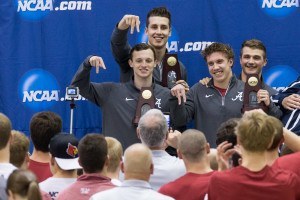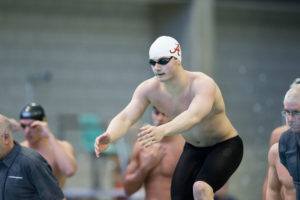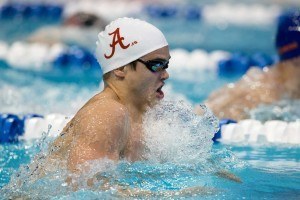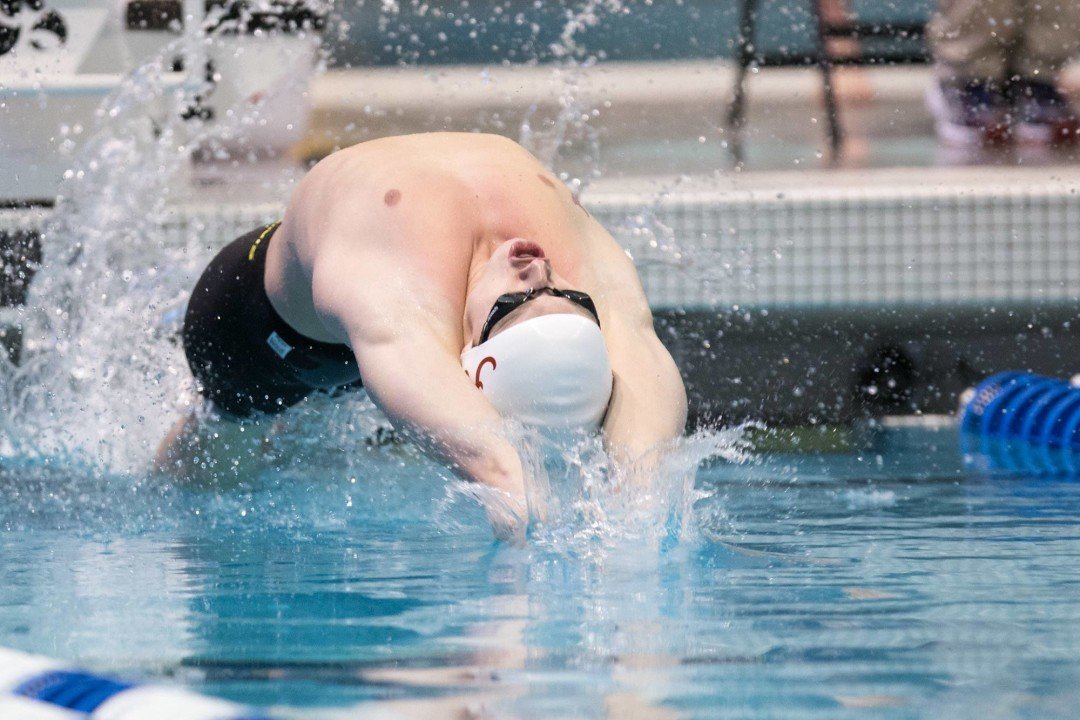We’ll be previewing the top 10 men’s and women’s programs from the 2016 NCAA Championships – stay tuned to our College Swimming Previews channel to catch all 20. Can’t get enough college swimming? Check out the College Preview issue of SwimSwam Magazine for more team previews and power rankings of every major Division I conference.
Key Losses: Kristian Gkolomeev (32 NCAA points, 4 NCAA relays), Brett Walsh (1 NCAA relay, SEC finalist), Crews Wellford (1 NCAA relay)
Key Additions: Zane Waddell (South Africa – sprint free), Daniel Kober (Germany – distance free), Chris Staka (CA – sprint back/fly/free), Kyle Maas (MI – back/IM)
2015-2016 Lookback

Alabama’s first-ever NCAA relay winners. (Photo credit: Tim Binning).
Graduating zero points from the 2015 NCAA Championships, Alabama’s stock continued to soar over the 2015-2016 season. At SECs, Connor Oslin came within a hair sweeping the backstroke titles, winning the 100 and taking 2nd in the 200 while ‘Bama nipped Mizzou for fourth overall.
Things got even better at NCAAs, with the Crimson Tide winning its first-ever relay title (a blistering 1:22.28 in the 200 medley relay) and finishing in a program-high 6th place overall.
That win especially came courtesy of an 18.00 anchor leg from Kristian Gkolomeev, tied for the second-fastest in history. Oslin was also 20.8 on backstroke, one of the top splits in the field.
Sprint Free: B+
It sure looked like Alabama was heading into a second consecutive year of returning all of its NCAA points – until three-time NCAA Champion Gkolomeev disappeared from the team’s roster. As it turns out, Gkolomeev only arrived on campus with three years of swimming eligibility. He’s still training and studying on the Alabama campus, but is no longer competing at the collegiate level.
That’s a huge blow to an Alabama sprint corps we had easily rated at A+ level prior to Gkolomeev’s departure. He had scored 32 individual points at NCAAs last year, and was an NCAA title winner in each of his three seasons: tying to win the 50 free in 2014, taking the 100 free in 2015 and winning that 200 medley relay in 2016.
The Crimson Tide does still return NCAA scorer Laurent Bams, who was a midseason addition last year from the Netherlands, and the team is incredibly deep at the conference level. Returning SEC scorers from last year include Bams (19.5/42.3), Robert Howard (19.8/43.7 at SECs), Luke Kaliszak (19.7 at SECs and two tenths faster at NCAAs) and Alex Gray (19.8 at SECs).
In addition, Alabama has South Africa’s Zane Waddell incoming – an international medalist at theYouth Commonwealth Games – along with California prospect Chris Staka, who is more of a fly/back type, but also goes 20.3 and 44.5 in the 50 and 100 frees.
The depth here is outstanding and the NCAA relays should still score points. But the loss of Gkolomeev and the graduated Brett Walsh accounts for a full letter grade loss here for the Tide.
Distance Free: C-
Right now, almost every SEC programs feels like it’s either built around the sprints (Auburn, Alabama, Missouri) or distance (Georgia, Tennessee) with a hole in the other discipline. Count Alabama firmly in the former category.
The Crimson Tide only had 3 scorers at the SEC level in the 500 and mile combined last year, and only 2 return. The biggest scorer was Anton McKee, who is actually a breaststroker, but was talented enough to go 4:19 in the 500 free at SECs. As a senior, Jack Hadjicontantinou should have a shot to score at the conference level in both races, but NCAA points will be very hard to come by.
The team did pick up Germany’s Daniel Kober, who specializes in open water swimming. Kober is hard to project at any specific level, but is probably worth some SEC points if he adapts well to the short course yards format, though again NCAA points seem a reach. In-state pickup Wyatt Harrison adds some depth and upside as well.
IM: C+
South Africa’s Chris Reid is a very solid IMer, but generally only swims the 200 with his main focus on the backstrokes. He could be an SEC finalist with a little improvement from his 1:45.6, but as long as the NCAA requires a 1:43-low to score, ‘Bama is probably out points here.
Michigan prospect Kyle Maas is in the same mold, with a 1:48 lifetime-best in the 200 IM but focusing mainly on backstroke. Kober is a bit of a wild card once again, but could be a factor in the 400.
Rising junior Taylor Charles is probably the team’s best full-time IMer, and scored in both races at SECs last year. But without any more true IMers to support him, Alabama will probably have to fight just to keep pace with the SEC’s and NCAA’s best in these events come the postseason.
Fly: A-

Luke Kaliszak (Photo Credit: Tim Binning)
Rising junior Luke Kaliszak was 5th at NCAAs in the 100 fly last year with a gigantic national meet. He doesn’t have a ton of room to move up there (Olympians Joseph Schooling, Caeleb Dressel and Jack Conger seem to have a monopoly on the top 3), but he’s still worth a bundle of NCAA points and some game-changing relay splits. In fact, Kaliszak tied for the 2nd-fastest 50 fly split nationwide last year at 20.02.
The sprint fly is great for Alabama, with three men returning at 47.0 or better: Kaliszak (45.1), Laurent Bams (46.92) and SEC champ backstroker Connor Oslin (47.0). Chris Staka, likely the team’s best freshman pickup, adds another threat with a 48.0 lifetime-best.
The 200 is a bit rougher, but once again Charles fills in a big gap after taking 13th at SECs last year. All-in-all, that’s a formula for Alabama to have another great national showing in the fly events, and plenty enough to keep pace in a rough-and-tumble SEC butterfly landscape.
Back: A+
But the backstrokes are where Alabama really shines. Were it not for Ryan Murphy constantly making history, it’d be Alabama’s Connor Oslin who was the biggest backstroke story of the NCAA. Coming out of high school with lifetime-bests of 48.9 and 1:51.5 in the 100 and 200 back, Oslin has become one of the better backstrokers in history heading into his senior season.
Oslin was the NCAA runner-up in the 100 back with a season-best of 45.1, and was 5th nationally with a 1:39.8 in the 200 back. That makes him a massive relay weapon and a 30+ point NCAA scorer heading into his farewell season.
If that’s not enough, the depth is absurd. Kaliszak (45.8 in the 100) and Reid (1:39.8 in the 200) both scored at NCAAs last year, and Reid was only a half-second away from scoring in the 100 as well.
Plus, the freshman class adds a 47.1 from Staka and a 48.4/1:48 combo from Maas, making what should be one of the nation’s best backstroke groups.
Breast: B+

Anton McKee (Photo credit: Tim Binning)
The Icelandic McKee is a breaststroke powerhouse coming off a fourth-place showing in the 200 at NCAAs. Now a senior, McKee could very well score in both races nationally – his lifetime-best would have scored in the 100 last year, and as it was, he missed 16th place in prelims by just .08 seconds.
McKee specializes in more distance-based races, but that works just fine for ‘Bama, which swaps in Russian senior Pavel Romanov on the 200 medley relay. Romanov has outstanding range (23.4 on that split, 52.7 in the 100 and 1:56.0 in the 200 last year) and held his own on the NCAA title-winning 200 medley relay.
There’s not much scoring capacity to speak of outside of those two, but the one-two punch by itself is good enough for an above average grade.
2016-2017 Outlook
Alabama looked like a likely top-5 program most of the offseason, but the loss of Gkolomeev can’t be overstated. Including his share (one-fourth) of the four relays he raced on, Gkolomeev accounted for 62 of ‘Bama’s 225 points at NCAAs that year – and there’s a strong argument to be made that he’s worth much more than 25% of those relays. Subtracting those points alone would have dropped the Crimson Tide all the way down to 11th.
That said, the incoming class is loaded with ever-valuable versatile sprinters, and the backstroke group is bordering on scary. Still, without that elite sprint force to cover over its weaknesses in distance free and IM, Alabama will have its work cut out for it to make a repeat appearance in the top 10 this coming year.

Losing Gkolomeev will be tough for Bama, but they have a huge men’s senior class this year that could be huge. Also, their freshman class has some genuine studs that will step up for them big this year.
P.S. there is no one named Chris Hadjicontantinou on the team….. It’s Jack Hadjiconstantinou
Also interesting Alabama’s freshman class wasn’t ranked in the top 12 recruiting classes, they seem to be loaded with talent.
I completely agree with Nigel Peyper. I had expected to find the men’s freshmen class rated in the top 12 in the nation. While Alabama didn’t recruit a large quantity of swimmers, they did recruit swimmers with tremendous quality who have the potential for significant improvement. With the addition of a new diving coach, I believe the divers will score points at conference and nationals. Even without Gkolomeev, I predict a top 10 finish at the NCAA championships.
Some notable times:
Luke Kalizsak was 19.5 last year, not 19.7
Alex Gray has been 19.6, it says 19.8
Anton Mckee was 4:14 two years ago and was a 4:17 last season.
Connor Oslin has been 46.76 100 fly,
This preview is for the 2016-2017 season and references times from the most recent season rather than lifetime-bests from several years in the past.
YEAH CHRIS!!!!!!!! GO THRESHERS!
….cannot be overstated…..
Call me crazy but I just don’t see how Alabama can be ranked this high with out Gkolomeev. They brought in plenty of talent but there’s no telling whether it will develop this season, and there’s no way that they can wholly replace Gkolomeev either. I think that Alabama is in for a top 15 showing at NCAA’s, but not much more than that.
The article agreed with you? They said it would be tough for Alabama to be top 10 again. They were sixth last year that’s why it says #6
Johnty Skinner will get it done